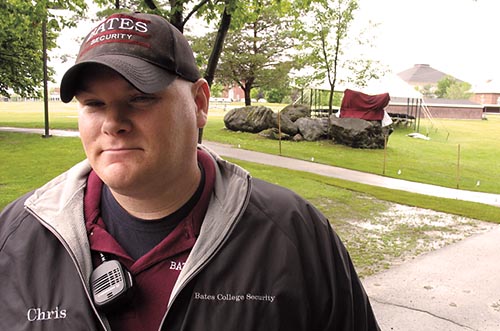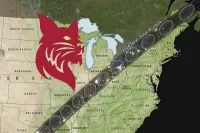Soon after students voted to make the bobcat the official Bates mascot in 1925, the Varsity Club stated its eagerness “to see a monument erected which will consist of a granite shaft with a life-size Bobcat in bronze before the present college year is ended.”
That year passed, as did 83 more, before Bates commissioned and happily dedicated, during Reunion 2009, the bronze Bobcat seen in this slide show. Designed by Maine artist Forest Hart, it’s atop a boulder near Leahey Field, where it exchanges greetings with people along the walk to and from Merrill Gymnasium and Underhill Arena.
Making the Bates Bobcat real was the Class of 2004’s potent cocktail of organizational skill, passion, and perseverance. They raised about $27,000 for their Senior Gift in 2004, asking the College to use it to create a bobcat sculpture. (Other fundraising efforts raised the total to nearly $50,000 by 2009.)
At the time, Bates officials tried to refocus the class gift — a bobcat still wasn’t in the plans. “They asked us to choose something a little less ambitious,” class co-president Tanya Schwartz ’04 recalled during the dedication on June 13.
But the class didn’t yield. Instead, “we rallied,” Schwartz said. True, it was a long rally, at five years, but co-president Eduardo Crespo ’04 said he was always confident that “our class’s work ethic and passion for Bates would take us all the way to today.”
The soft-spoken Hart, having met Crespo and Schwartz at the Reunion dedication in June, was dazzled. “Seems to me they could do anything they set their minds to,” he said. “A Bobcat sculpture or world peace.”
Five years ago, faced with the Class of 2004’s high seriousness, Bates channeled their energy by forming the College’s first Public Art Committee, which in 2007 drafted a policy to guide all such projects. Then, a Bobcat Selection Committee of faculty, staff, and 2004 alums guided the process, including a public presentation in spring 2008 by three artists chosen by the committee, including Hart.
Each artist’s proposal was in turn shared with the Class of 2004, which embraced Hart’s realistic interpretation of an athletic predator on the move, one that echoed the College’s official Bobcat logo. “I love that the Bobcat is in motion — [it] speaks to the ever-evolving and dynamic nature of academics and Bates College,” wrote Julia Allen ’04 in an e-mail response to Hart’s presentation.
(Hart, who lives in Monroe, halfway between Bangor and Belfast, has a strong background in taxidermy but knows his live cats, too. “I’ve made five bobcat sightings in the last 10 months,” he said.)
Albeit long, the process was pure Bates, “democratic and egalitarian,” said Mark Bessire, former director of the Bates Museum of Art and chair of the Public Art Committee and now director of the Portland Museum of Art. When you have a solid process marked by “intelligence and spirit,” he said, “you end up with great art. Process equals excellence.”
In the end, the project’s success belies the 84-year-old notion of institutional rigidity, Crespo told the audience. “The one thing that was present all along [was] this institution’s capacity to welcome excellence and change.”
The Bobcat Statue
- Artist: Forest Hart of Monroe, Maine
- Size: twice life size (60 inches long)
- Medium: bronze (copper, silicon, magnesium). The sculpture comprises 25 separate pieces welded together
- Thickness: quarter-inch
- Weight: 250 pounds
- Foundry: Lands End Sculpture Center, Paonia, Colo.
- Artist’s quote: “What struck me the most was the enthusiasm and passion of the Class of 2004. What wonderful, positive energy. I was proud to have been chosen and proud to be a part of the project.”





